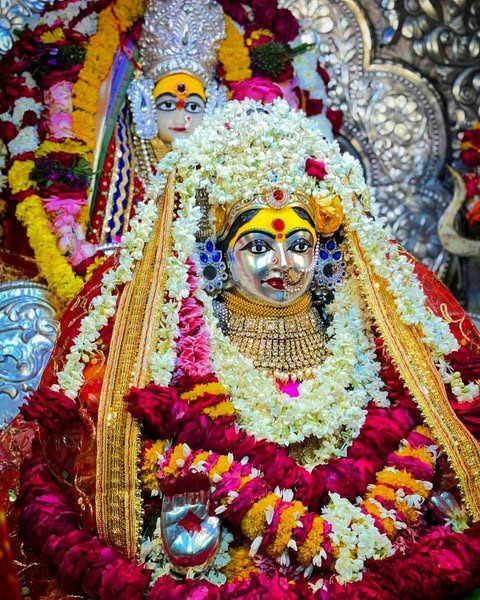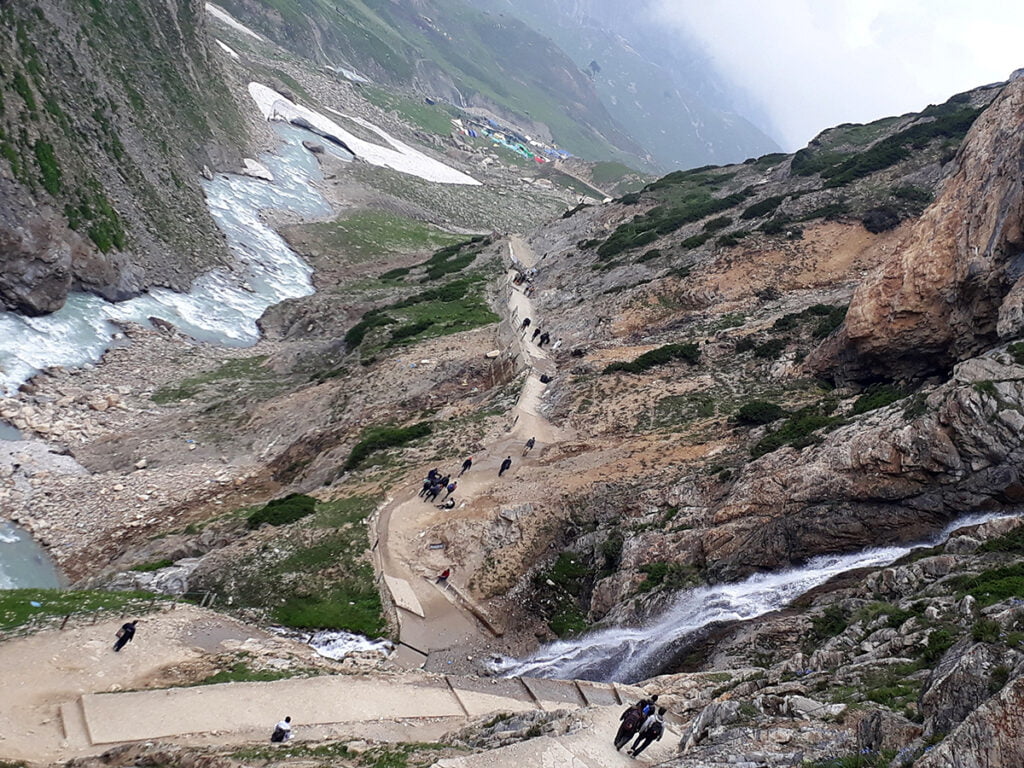High in the mystic mountains of Ladakh, where the rugged landscapes meet the spiritual silence of the Himalayas, lies the Shri Parvat Shakti Peeth, one of the revered 51 Shakti Peethas. According to Hindu belief, this sacred site marks the spot where the anklet (nupur) of Goddess Sati fell, sanctifying the land with divine feminine energy.
Here, the goddess is worshiped as Devi Sundari, a radiant and beautiful form of Shakti, while Lord Shiva is venerated as Sundaranand Bhairav. This pairing represents balance – divine beauty with strength, and eternal bliss with protection.
While Ladakh is famed for its monasteries and Buddhist culture, the presence of Shri Parvat Shakti Peeth makes it equally significant in Hindu tradition, drawing pilgrims who wish to experience the union of spiritual energy and natural grandeur.

Mythological Significance
The story of Shri Parvat Shakti Peeth originates from the timeless tale of Sati and Shiva. When Goddess Sati sacrificed herself in Daksha’s yagna, Lord Shiva, overcome with grief, carried her lifeless body across the universe. To restore cosmic balance, Lord Vishnu used his Sudarshan Chakra to cut her body into pieces, which fell at different locations, creating the Shakti Peethas.
At Shri Parvat in Ladakh, the anklet of Sati fell, making this land sacred. The anklet, a symbol of rhythm and grace, is tied to the concept of cosmic dance (Tandava and Lasya). In this sense, Shri Parvat represents the rhythm of the universe, where creation and destruction balance each other in the eternal cycle of life.
Here, Sati is worshiped as Devi Sundari, symbolizing divine beauty and spiritual radiance. Her guardian is Sundaranand Bhairav, representing the blissful yet protective form of Lord Shiva.
Religious Importance
The Shri Parvat Shakti Peeth is not just a place of worship but a spiritual powerhouse. Pilgrims who reach this sacred mountain believe they are stepping into a zone where earthly energy merges with cosmic vibration.
Devi Sundari embodies:
- Beauty of the soul – reminding devotees that inner purity reflects outer beauty.
- Compassion and grace – guiding pilgrims to live harmoniously.
- Strength hidden in gentleness – a reminder that Shakti is both nurturing and fierce.
For devotees of Shaktism, Shri Parvat is a reminder of divine completeness – beauty (Sundari) supported by bliss (Sundaranand Bhairav).
Location and Landscape
Shri Parvat Shakti Peeth is located in Ladakh, Jammu and Kashmir, in the heart of the Himalayas. While its exact ancient shrine is difficult to pinpoint due to geographical shifts and legends, local traditions place it amidst the mystical high-altitude ranges, often associated with areas near Zanskar and Kargil.
- Altitude & Climate: At over 10,000 feet above sea level, Ladakh’s thin air and cold winds add to the temple’s challenging but spiritually rewarding environment.
- Natural Beauty: Surrounded by stark mountains, glacial streams, and serene valleys, the site resonates with tranquility. Many pilgrims describe it as a place where silence itself becomes prayer.
Accessibility
Reaching Shri Parvat is not as simple as visiting a city temple, but the journey itself is an act of devotion.
- By Air: The nearest airport is Kushok Bakula Rimpochee Airport in Leh, connected to Delhi, Srinagar, and Chandigarh.
- By Road: From Leh, devotees travel by road to reach Kargil or nearby areas, depending on the chosen pilgrimage route.
- By Trek: Some stretches may require trekking through mountainous terrain, which adds to the adventure and sanctity of the journey.
Due to Ladakh’s weather, the temple is best visited between May and September, when the roads are open and conditions are stable.
Architecture and Sacred Aura
Unlike grand stone temples, the Shri Parvat Shakti Peeth carries a simpler spiritual aura. Its importance lies less in monumental architecture and more in the natural temple of mountains.
- Local shrines or small temples dedicated to Devi Sundari are often adorned with red cloth, bells, and symbols of Shakti.
- Devotees carry sindoor, coconuts, flowers, and anklets as symbolic offerings to the goddess.
- A nearby shrine or space is always dedicated to Sundaranand Bhairav, without whose worship darshan is considered incomplete.
The mountains themselves are seen as the true temple, where every rock, stream, and gust of wind carries the presence of the goddess.
Rituals and Worship
At Shri Parvat, the worship follows traditional Shakta customs but with a Himalayan simplicity.
- Morning & Evening Aarti: Devotees chant mantras dedicated to Sundari Mata, lighting lamps against the cold winds.
- Anklet Offering: Since this is where the anklet fell, many pilgrims offer silver anklets or bangles as a mark of devotion.
- Navratri Celebrations: The site witnesses special pujas during Navratri, attracting pilgrims from across the region.
- Bhairav Puja: Worship of Sundaranand Bhairav is performed after Sundari’s darshan for blessings of protection.
Devotees believe that prayers at Shri Parvat bless them with beauty, strength, protection, and freedom from negative energies.
FAQs for Shri Parvat Shakti Peeth, Ladakh
1. Why is Shri Parvat Shakti Peeth famous?
It is one of the 51 Shakti Peethas, believed to be the place where the anklet of Goddess Sati fell, making it a sacred site of worship.
2. Where is Shri Parvat Shakti Peeth located?
It is located in the mountainous region of Ladakh, a high-altitude pilgrimage site.
3. What is worshipped at Shri Parvat Shakti Peeth?
The temple is dedicated to Goddess Sundari (Shakti), symbolizing beauty, energy, and divine power.
4. What are the temple timings?
Due to its remote location, timings may vary, but generally 6:00 AM to 7:00 PM is observed for rituals and darshan.
5. Is photography allowed at Shri Parvat Shakti Peeth?
Photography rules vary; usually not allowed inside sanctum, but permitted in the surrounding mountains.
6. What is the significance of Shri Parvat Shakti Peeth?
It is revered as the spot where Devi Sati’s anklet fell, making it spiritually powerful and a major Shakti Peeth.
7. How can I reach Shri Parvat Shakti Peeth?
It can be reached via Leh in Ladakh, followed by road journeys through mountain passes. Nearest airport: Leh Airport.
8. Are there special rituals at Shri Parvat Shakti Peeth?
Yes, rituals include daily aarti, offerings, and Navratri pujas performed with devotion.
9. Is there accommodation near Shri Parvat Shakti Peeth?
Pilgrims can stay in guesthouses, homestays, and lodges available in Leh and nearby regions.
10. What is the best time to visit Shri Parvat Shakti Peeth?
The ideal time is May to September, as heavy snowfall makes the region inaccessible in winter.


